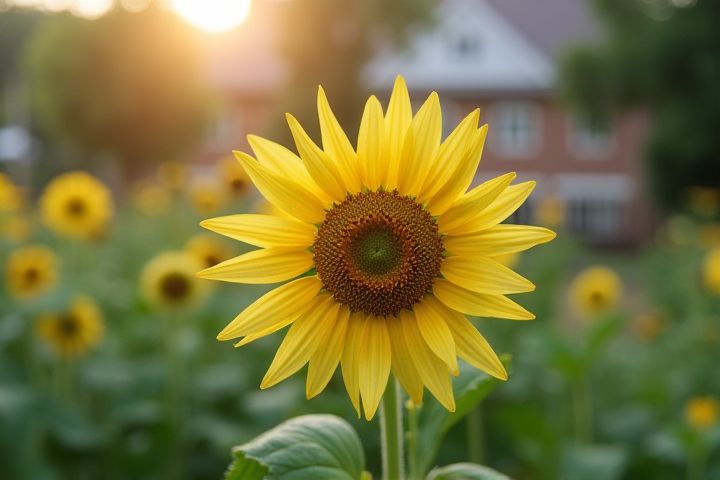
When selecting plants to enhance the beauty of your home, consider low-maintenance options like evergreen shrubs, which provide year-round greenery. Perennials such as hostas and daylilies thrive in various conditions, adding vibrant blooms that attract pollinators. Incorporating decorative grasses can offer texture and movement, enhancing visual interest throughout the seasons. If you want a fragrant element, plant lavender or rosemary near pathways for a delightful aroma. Always consider your local climate and soil conditions to ensure that your chosen plants will flourish, creating a harmonious landscape around your house.
What To Plant Around A House
Native plants
Planting native plants around your house enhances biodiversity while promoting eco-friendliness. For instance, consider incorporating Eastern Redbud (Cercis canadensis), which attracts pollinators with its stunning pink flowers and matures to about 20-30 feet tall. Complement your garden with native grasses like Little Bluestem (Schizachyrium scoparium), which thrives in a variety of soil conditions, grows 2-4 feet tall, and provides excellent habitat for wildlife. By utilizing these species, your garden can support local ecosystems, reduce water usage, and require minimal maintenance, all while beautifying your landscape.
Drought-tolerant species
Consider planting native drought-tolerant species such as lavender, which thrives in dry conditions and attracts pollinators. Succulents like agave and sedum are ideal for low-maintenance gardens, offering unique textures and vibrant colors. Ornamental grasses such as blue fescue or tufted hairgrass provide visual interest and help enhance your home's curb appeal while resisting drought. Incorporating these resilient plants not only conserves water but also creates a sustainable landscape.
Pollinator-friendly options
Consider planting native wildflowers such as Coneflowers (Echinacea) and Black-eyed Susans (Rudbeckia), which attract bees and butterflies. With a planting zone suitable for most regions, adding flowering herbs like Lavender and Thyme will not only enhance your garden's aroma but also provide nectar for pollinators. By incorporating plants like Milkweed (Asclepias), you can support Monarch butterflies, which rely on these plants for their lifecycle. Aim for a diverse selection, including at least 5 to 10 different species, to create a vibrant and ecologically valuable landscape around your home.
Evergreen shrubs
Evergreen shrubs, such as Boxwood (Buxus spp.), provide year-round interest and privacy, thriving in various climates and conditions. Consider planting Rhododendron or Azalea for vibrant blooms in spring while maintaining their lush green foliage throughout the year. A well-placed Holly (Ilex spp.) can offer both visual appeal and seasonal berries, attracting birds to your garden. To create a more structured landscape, you might also explore Yew (Taxus spp.), which can be easily shaped and adds a formal touch to your property.
Rain garden plants
Rain gardens thrive on moisture, making native plants an optimal choice. Consider incorporating species like Blue Flag Iris (Iris versicolor) and Joe Pye Weed (Eutrochium purpureum), which can tolerate both wet and dry conditions, thriving in USDA zones 3-9. For ground cover, Lemon Balm (Melissa officinalis) and Creeping Jenny (Lysimachia nummularia) effectively manage erosion while providing aesthetic appeal. You can enhance biodiversity by attracting pollinators with flowers like Milkweed (Asclepias spp.), beneficial for monarch butterflies, or coneflowers (Echinacea spp.), known for their resilience and charming blooms.
Edible landscaping
Incorporating edible landscaping around your house not only enhances aesthetics but also provides fresh produce. Consider planting herbs like basil, rosemary, and thyme in decorative pots or along pathways, as they thrive in full sun and add fragrance. Fruit-bearing plants such as strawberries, raspberries, or dwarf apple trees can flourish in small spaces, producing delicious yields while attracting pollinators. For a visually appealing and nutritious ground cover, opt for low-growing vegetable varieties like lettuce or spinach, which can be intermingled with ornamental flowers throughout your garden.
Foundation plantings
Foundation plantings should enhance your home's aesthetic while providing functional benefits, such as moisture control and insulation. Ideal choices include evergreen shrubs like Boxwood (Buxus spp.), which can grow up to 4 feet tall, and low-maintenance perennials such as Daylilies (Hemerocallis spp.), known for thriving in various climates. Use flowering plants like Hydrangeas, which can reach heights of 3 to 10 feet, to add seasonal color and visual appeal while attracting pollinators. A well-planned foundation planting can help reduce energy costs by up to 25% by providing shade and windbreaks, thus improving your home's overall efficiency.
Companion planting
Companion planting enhances garden vitality by encouraging beneficial relationships between plants. Marigolds, featuring vibrant orange and yellow blooms, repel harmful insects such as nematodes and aphids, making them excellent companions for tomatoes, peppers, and cucumbers. Basil, when paired with tomatoes, not only boosts their growth but also improves flavor and deters pests like whiteflies. Incorporating herbs like chives or mint near your vegetables can protect them against aphids while providing fragrant foliage for your culinary delights.
Seasonal blooms
For a vibrant landscape, consider planting seasonal blooms like tulips and daffodils in spring, which offer a burst of color with their striking petals. In summer, you can enhance your garden with lavender and coneflowers, both known for their aromatic qualities and ability to attract pollinators. As autumn approaches, chrysanthemums and asters bring rich hues that brighten up the fading landscape. Finally, winter pansies provide a splash of color during the colder months, ensuring your garden remains alive and inviting year-round.
Privacy hedges
For enhancing privacy around your house, consider planting fast-growing hedges like Leyland Cypress, which can reach heights of up to 60 feet and provide a dense screen. Another excellent choice is Arborvitae, particularly the Emerald Green variety, known for maintaining a compact form while growing 10 to 15 feet tall. If you're looking for something flowering, the Bamboo species, such as Fargesia, offers additional vertical growth and lush foliage, with some varieties growing up to 20 feet. With a well-planned hedge row, you can create an effective natural barrier that not only enhances privacy but also adds aesthetic value to your property.
